Sony NEX-FS100EK, NEX-FS100E, NEX-FS100P, NEX-FS100PK Operating Guide

Interchangeable Lens Digital HD
Video Camera Recorder
Operating Guide
E-mount
4-279-232-12(1)
Table of Contents
Getting Started
Recording/Playback
Editing
Using the Menu
Connecting with another device
Troubleshooting
Additional Information
Quick Reference
NEX-FS100E/FS100P/FS100EK/FS100PK
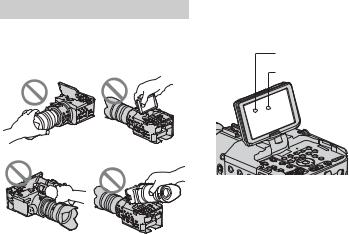
Read this first
Before operating this unit, please read this manual thoroughly, and retain it for future reference.
Notes on use
Using the camcorder
•Do not hold the camcorder by the following parts.
some tiny black points and/or bright points (white, red, blue, or green in color) that appear constantly on the LCD screen. These points are normal results of the manufacturing process and do not affect the recording in any way.
White, red, blue or green point
Black point
Lens |
LCD screen |
Microphone or |
Large LCD |
Microphone holder |
viewfinder |
b Notes
•The camcorder is not dustproof, dripproof or waterproof. See “About handling of your camcorder” (p. 107).
•When connecting the camcorder to another device with communication cables, be sure to insert the connector plug in the correct way. Pushing the plug forcibly into the terminal will damage the terminal and may result in a malfunction of the camcorder.
•Use GPS in accordance with the regulations of the situation, the countries/regions of use.
On the LCD screen and lens
•A menu item that is grayed out is not available under the current recording or playback conditions.
•The LCD screen is manufactured using extremely high-precision technology, so over 99.99% of the pixels are operational for effective use. However, there may be
•Do not record the sun or leave the camcorder under the sun for a long time. The inside of the camcorder may be damaged. If sunlight is focused on a nearby object, it may cause a fire. When you must place the camcorder under direct sunlight, attach the front lens cap.
•Do not expose your camcorder’s viewfinder, lens, or LCD screen to the sun or strong light source for extended periods. Doing so may cause a malfunction of the camcorder.
•Do not attempt to record the sun directly. Doing so may cause a malfunction of the camcorder. You may record a sunset, as the light is not as strong as that at midday.
On the temperature of your camcorder and battery pack
Your camcorder has a protective function that disables recording or playback if the temperature of your camcorder or battery pack is beyond the safely operable range. In this case, a message appears on the LCD screen (p. 97).
2
On recording
•In order to stabilize memory card operation, it is recommended that you format the memory card when you use it with your camcorder for the first time. All data recorded on the memory card will be erased by formatting, and cannot be recovered. Save important data on the memory card on other media such as a computer, before formatting the memory card.
•Before starting to record, test the recording function to make sure the picture and sound are recorded without any problems.
•Compensation for the loss of the content of recordings or the loss of recording opportunities cannot be provided, even if recording or playback is not possible due to a malfunction of the camcorder, storage media, etc., or even if images or sounds are distorted due to the limits of the capabilities of the camcorder.
•TV color systems differ depending on the countries/regions. To view your recordings on a TV, you need a PAL system TV.
•Television programs, films, video tapes, and other materials may be copyrighted. Unauthorized recording of such materials may be contrary to the copyright laws.
•Because of the way that the image device (CMOS sensor) reads out image signals, the following phenomena may occur.
–The subjects passing by the frame rapidly might appear crooked depending on the recording conditions. (This phenomenon may be notable in displays having high motion resolution.)
–Horizontal lines appear on the screen during recording under fluorescent lights. The phenomena can be reduced by adjusting the shutter speed (p. 32).
–Images on the screen look horizontally divided when a subject is continuously lit with a flash. The effect of this phenomenon may be reduced by using a slower shutter speed. Also, you may try using the “Content
Management Utility” software on the supplied CD-ROM to repair the image.
On playing back movies
•Movies recorded using this camcorder may not play back normally on devices other than this camcorder. Also, movies recorded on other devices may not play back properly on this camcorder.
•Standard (SD) image quality movies recorded on SD memory cards cannot be played on AV devices of other manufacturers.
DVD media recorded with high definition image quality (HD)
DVD media recorded with high definition image quality (HD) can be played back with devices that are compatible with the AVCHD standard. You cannot play discs recorded with high definition image quality (HD) with DVD players/recorders as they are not compatible with the AVCHD format. If you insert a disc recorded with the AVCHD format (high definition image quality (HD)) into a DVD player/recorder, you may not be able to eject the disc.
Save all your recorded image data
•To prevent your image data from being lost, save all your recorded images on external media periodically. To save images on a computer, see page 87. To save images on an external device, see page 83.
•Movies recorded with [1080/50p PS] or
[1080/50i FX] of [ REC FORMAT] can be saved on an external media device only (p. 83).
REC FORMAT] can be saved on an external media device only (p. 83).
To handle the recorded images on your computer
Refer to “Help” on the supplied CD-ROM “Content Management Utility.”
Continued , 3

Read this first (Continued)
Format the recording media using [MEDIA FORMAT] if images are not recorded or played back properly
If you continue recording and deleting images on recording media for a long time, the files on that recording media may be fragmented. As a result, you may not be able to record and save images properly. If this happens, save images on a separate recordable media, such as a disc or computer, then format the recording media (p. 63).
Note on disposal/transfer
Even if you format the recording media on your camcorder or computer, you may not delete data from the recording media completely. When you transfer the recording media or your camcorder, it is recommended that you delete the data completely using commercially available data deletion software to prevent the recovery of your data. Also, when you dispose of the recording media, it is recommended that you destroy the actual body of the recording media.
About the operation of the camcorder
You can operate the camcorder using the SEL/PUSH EXEC dial (p. 21, 66), V/v/B/ b/EXEC buttons (p. 66), and the touch panel. However, you cannot use the touch panel to make some settings such as the MENU items.
About this manual
•Operations in the manual are described using the E 18-200 mm F3.5-6.3 OSS lens supplied with the NEX-FS100EK/ FS100PK. When the operation differs depending on the lens used, you will find the relevant information in “Notes” or “Tips.”
•Memory cards and a flash memory unit are both referred to as recording media in this manual.
•The images of the LCD screen used in this manual for illustration purposes are
captured using a digital still camera, and therefore may appear different.
•The on-screen displays in each local language are used for illustrating the operating procedures. Change the screen language before using your camcorder if necessary (p. 22).
•Design and specifications of recording media and other accessories are subject to change without notice.
•Illustrations of camcorders in this manual show the NEX-FS100EK/FS100PK unless otherwise specified.
About the location of the nameplate
The nameplate is located on left side of the unit (circled below).
4

Table of Contents |
|
Read this first ........................................................................................... |
2 |
Getting Started |
|
Step 1: Checking supplied items .............................................................. |
8 |
Step 2: Attaching the supplied accessories ............................................ |
10 |
Step 3: Charging the battery pack .......................................................... |
15 |
Step 4: Attaching the lens ...................................................................... |
18 |
Step 5: Turning on the camcorder and setting the date and time .......... |
21 |
Changing the language setting .......................................................... |
22 |
Step 6: Inserting a memory card/Attaching a flash memory unit ............ |
23 |
Recording/Playback |
|
Recording ............................................................................................... |
26 |
Selecting high definition image quality (HD) or standard definition |
|
image quality (SD) .............................................................................. |
28 |
Selecting the recording format ........................................................... |
28 |
Zooming .............................................................................................. |
29 |
Adjusting the focus ............................................................................. |
29 |
Adjusting manually ................................................................................. |
31 |
Adjusting the iris ................................................................................. |
31 |
Adjusting the gain ............................................................................... |
31 |
Adjusting the shutter speed................................................................ |
32 |
Adjusting the white balance................................................................ |
33 |
Adjusting the black balance ............................................................... |
34 |
Audio setup ............................................................................................ |
35 |
Recording sound via the supplied microphone.................................. |
36 |
Recording sound from an external audio device................................ |
36 |
Adjusting the volume .......................................................................... |
37 |
Setting the headphone sound............................................................. |
37 |
Useful functions ...................................................................................... |
38 |
Customizing the picture quality (Picture profile)................................. |
38 |
Acquiring location information (GPS).................................................. |
43 |
Setting time data ................................................................................. |
44 |
Recording with the SMOOTH SLOW REC function............................. |
45 |
Recording with the Slow & Quick Motion function .............................. |
46 |
Reviewing the most recently recorded scene (Last Scene Review)... |
48 |
Assigning the functions to the ASSIGN buttons ..................................... |
48 |
Contents of Table
Continued , 5
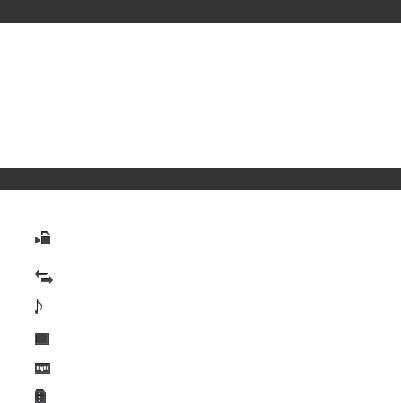
Table of Contents (Continued) |
|
Playback ................................................................................................ |
50 |
Viewing still images ............................................................................. |
52 |
Changing/checking the settings in your camcorder ............................... |
54 |
Changing the screen........................................................................... |
54 |
Displaying recording data (Data code)............................................... |
54 |
Displaying the settings in your camcorder (Status check) ................. |
55 |
Connecting a monitor or a TV ................................................................ |
56 |
Editing |
|
Protecting recorded images (Protect) .................................................... |
58 |
Capturing still images from a movie ....................................................... |
59 |
Dividing a movie ..................................................................................... |
60 |
Deleting movies and still images ............................................................ |
61 |
Copying movies/still images ................................................................... |
62 |
Formatting the recording media ............................................................. |
63 |
Preventing data on recording media from being recovered ................... |
64 |
Repairing the image database file ......................................................... |
65 |
Using the Menu |
|
Operating the menu ............................................................................... |
66 |
Menu items ............................................................................................ |
68 |
(CAMERA SET) menu .................................................................... |
71 |
Settings to adjust your camcorder to the recording conditions |
|
(GAIN SET/STEADYSHOT, etc.) |
|
(REC/OUT SET) menu ................................................................... |
73 |
Recording settings, input and output settings (REC SET/VIDEO OUT)
(AUDIO SET) menu ........................................................................... |
74 |
Settings for the audio recording (  AUDIO FORMAT/XLR SET, etc.)
AUDIO FORMAT/XLR SET, etc.)
(DISPLAY SET) menu ..................................................................... |
76 |
Display settings (MARKER/DISPLAY OUTPUT, etc.) |
|
(TC/UB SET) menu ......................................................................... |
79 |
Time code settings (TC PRESET/UB PRESET, etc.) |
|
(OTHERS) menu .............................................................................. |
80 |
Settings while recording or other basic settings (AREA SET/BEEP, etc.)
6

Connecting with another device |
|
Saving images on an external media device .......................................... |
83 |
Creating a high definition image quality (HD) disc with a DVD writer ..... |
85 |
Creating a standard definition image quality (SD) disc |
|
with a recorder, etc. .................................................................... |
86 |
Saving images with a computer ............................................................. |
87 |
Troubleshooting |
|
Troubleshooting ...................................................................................... |
89 |
Warning indicators and messages ......................................................... |
97 |
Additional Information |
|
Recording time of movies ....................................................................... |
99 |
Using your camcorder abroad .............................................................. |
101 |
File/folder structure on the memory card and the flash memory unit ... |
102 |
Maintenance and precautions .............................................................. |
103 |
About the AVCHD format .................................................................. |
103 |
About GPS ........................................................................................ |
103 |
About the memory card .................................................................... |
104 |
About the “InfoLITHIUM” battery pack ............................................. |
105 |
About charging the battery pack ...................................................... |
106 |
About handling of your camcorder ................................................... |
107 |
Specifications ....................................................................................... |
110 |
Quick Reference |
|
Identifying parts and controls ............................................................... |
114 |
Screen indicators .................................................................................. |
120 |
Index ..................................................................................................... |
121 |
Contents of Table
7
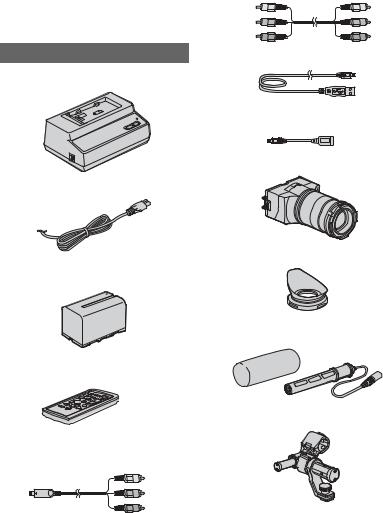
Getting Started
Step 1: Checking supplied items
Make sure that you have following items supplied with your camcorder.
The number in the parentheses indicates the number of that item supplied.
All models
AC Adaptor/Charger (AC-VL1) (1) (p. 15)
Power cord (mains lead) (1) (p. 15)
Rechargeable battery pack (NP-F770) (1) (p. 15, 105)
Wireless Remote Commander (RMT-845)
(1) (p. 119)
A button-type lithium battery is already installed.
A/V connecting cable (1) (p. 56, 86)
USB cable (1) (p. 87)
USB Adaptor Cable (1) (p. 83)
Large LCD viewfinder (1) (p. 13)
Large eyecup (1) (p. 13)
Wind Screen (1), Microphone (ECM-XM1)
(1) (p. 11)
Handle (1) (p. 10)
Component video cable (1) (p. 56)
8
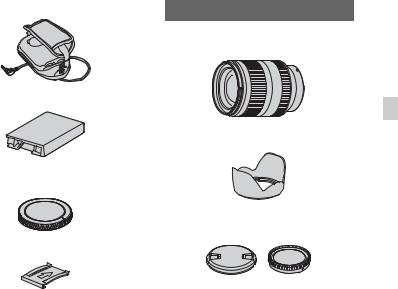
Grip (1) (p. 12)
Flash memory unit jack cover (1) (p. 25)
Body cap (attached to the camcorder) (1) (p. 18)
Accessory shoe plate (1) (p. 15)
Connecting cord (DK-415) (1) (p. 17)
CD-ROM “Content Management Utility” (1)
CD-ROM “Manuals for Interchangeable Lens Digital HD Video Camera Recorder”
(1)
Operating Guide (2)
NEX-FS100EK/FS100PK
Zoom lens (E 18-200 mm F3.5-6.3 OSS)
(1) (p. 18)
Lens hood (1) (p. 20)
Front lens cap (1), rear lens cap (1) (attached to the lens) (p. 18)
Started Getting
9
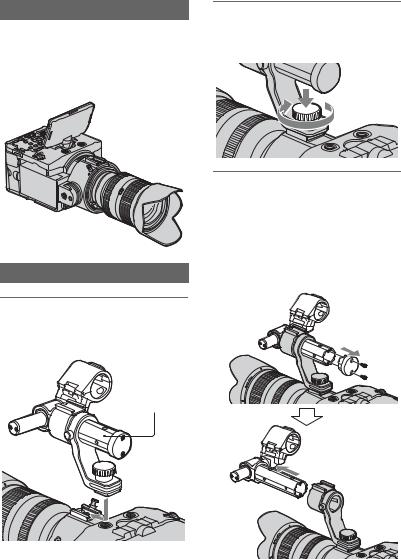
Step 2: Attaching the supplied accessories
Attaching the lens
See page 18 for information on attaching the lens. The NEX-FS100E/FS100P does not come with the E 18-200 mm F3.5-6.3 OSS lens. Please use appropriate lenses (sold separately).
Attaching the handle
1 Slide the handle into the accessory shoe in the direction of the arrow.
2 While pressing the screw down, turn it clockwise to fasten the handle.
If the light to the lens is blocked
Certain types of microphone may block the light to the lens. If this happens, attach the handle facing the other way round.
1Remove the screws and cap of the handle slide bar, and pull the handle slide bar out.
Handle slide bar
10
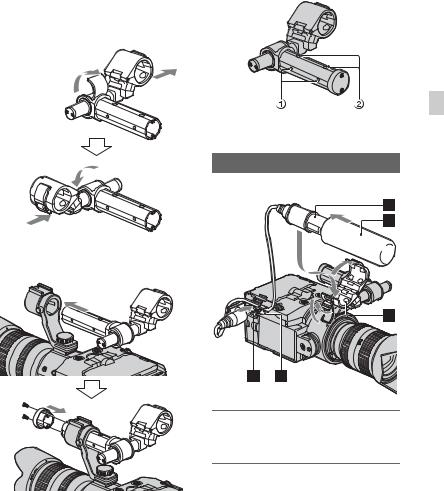
2Reattach the microphone holder so that it faces up.
Pull the microphone bar out. Insert the microphone bar from the opposite side.
3Insert the handle slide bar from the opposite side, and replace the cap and screws.
b Tips
•The screw holes of the handle slide bar are for following screws.
1 For 1/4-20UNC screws
2 For 3/8-16UNC screws
Attaching the microphone
Attach the microphone to the handle.
1 Attach the wind screen B to the supplied microphone A.
2 Place the microphone A in the microphone holder C with the model name facing upward, close the cover, and shut the clamp.
Started Getting
Continued , 11
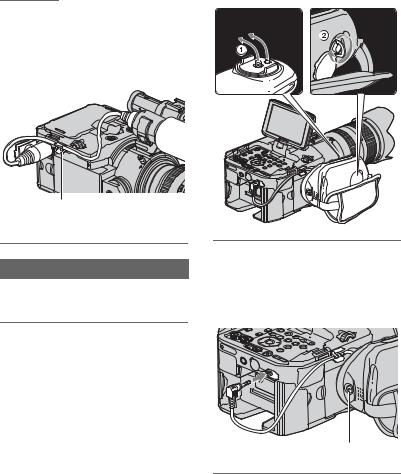
Step 2: Attaching the supplied accessories (Continued)
3 Connect the plug of the microphone to the INPUT 1 jack
D.
Put the microphone cable into the cable clamp E.
Cable clamp
Attaching the grip |
2 Connect the cable to the REMOTE |
jack. |
You can rotate the grip to suit shooting angles.
1 Align the grip receptacle 1 and locating hole of the camcorder with the screw and boss of the grip. Choose the grip angle, and fasten the grip securely by turning the knob 2 clockwise.
Connecting the cable allows you to start/stop recording by using the record button on the grip.
Record button
When changing the grip angle
Unfasten the knob, adjust the angle, then tighten the knob.
12
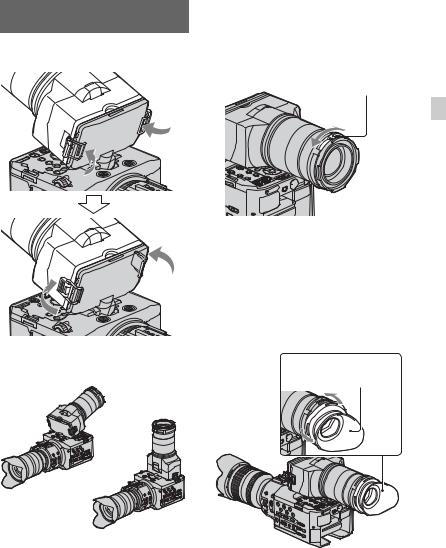
Attaching the large LCD viewfinder
Attach the large LCD viewfinder to the LCD screen.
Adjusting the viewfinder lens
Turn the viewfinder lens adjustment ring so that you can see the image on the LCD screen clearly.
Viewfinder lens adjustment ring
Turn it until the picture becomes clear.
Started Getting
You can use the viewfinder in the following 2 ways, depending on your shooting angle.
z Tips
•You can set and hold the LCD screen angle (p. 14).
When the picture on the LCD screen is hard to see
If you cannot see the picture on the LCD screen clearly under bright circumstances, use the supplied large eyecup. To attach the large eyecup, stretch it slightly and align it with the groove in the large LCD viewfinder. You can attach the large eyecup facing either the right or left side.
Large eyecup (supplied)
Continued , 13
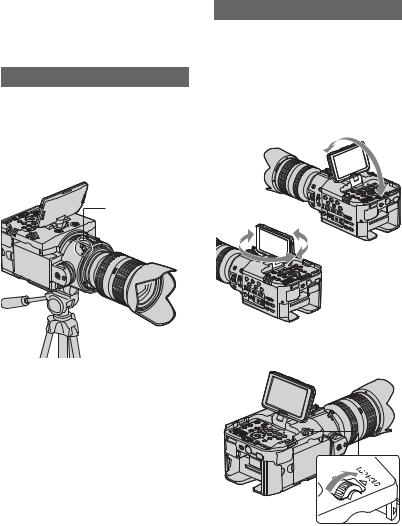
Step 2: Attaching the supplied accessories (Continued)
z Tips
•If you are farsighted and have a trouble seeing images on the camcorder screen, you can attach a 52 mm close-up lens (sold separately) to the viewfinder lens adjustment ring.
Using the tape measure hook
The tape measure hook is attached at the image sensor position.
When you want to measure the precise distance between the image sensor and the subject, hook the end of a tape measure here.
Tape measure hook
Using the LCD screen
The LCD panel is placed above the centerline of the lens, on the same angle as the lens views the subject, so the subject will be captured as you see it. The LCD screen can be rotated right or left, allowing a person other than the camera operator to see the image.
150 degrees
180 degrees
90 degrees
You can set and hold the LCD screen angle by turning the LCD HOLD dial.
Loosen the LCD HOLD dial when you change the angle.
14
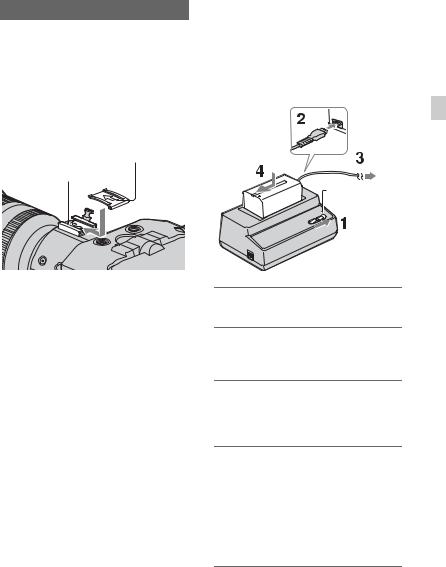
Using the accessory shoe
When attaching an accessory other than the handle, attach the accessory shoe plate to the accessory shoe.
Attaching the accessory shoe plate
Insert the accessory shoe plate in the direction of the arrow on the plate surface until the end of the plate engages the end of the shoe.
Accessory shoe plate
Accessory shoe
Step 3: Charging the battery pack
You can charge the “InfoLITHIUM” battery pack (L series) with the supplied AC Adaptor/Charger.
b Notes
•You can use a large capacity battery back, NPF770 (supplied) or NP-F970 (sold separately), with your camcorder. You cannot use NP-F570.
Charge lamp
1 Set the mode switch to CHARGE.
2 Connect the power cord (mains lead) to the AC Adaptor/Charger.
3 Connect the power cord (mains lead) to the wall outlet (wall socket).
4 Place the battery pack in the slot of the AC Adaptor/Charger, press it down, and slide it in the direction of the arrow as illustrated.
The charge lamp turns on and charging starts.
Started Getting
Continued , 15
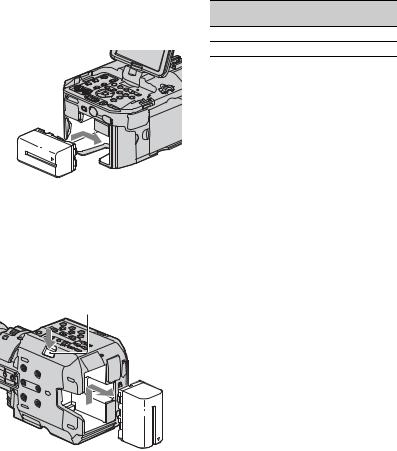
Step 3: Charging the battery pack (Continued)
After charging the battery
The charge lamp turns off (normal charge). If you continue charging more 1 hour after the charge lamp turns off, you can use the battery a little longer (full charge). Remove the battery pack from the AC Adaptor/Charger when the charge is completed.
To attach the battery pack
Press the battery pack against the back of your camcorder and slide it right as shown below.
z Tips
•You can check the remaining battery life with the status check function (p. 55).
To store the battery pack
If the battery pack is not in use for a while, run down the battery and store it. See page 106 for details on storage of the battery pack.
Charging time
Approximate time (minute) required when you charge a fully discharged battery pack.
Battery pack |
Normal charge |
Fully charge |
|
time |
time |
||
|
|||
NP-F770 |
250 |
310 |
|
NP-F970 |
365 |
425 |
b Notes
•The supplied battery pack is NP-F770.
•You cannot use the NP-F570 battery pack with your camcorder.
On the battery pack
•Before changing the battery pack, slide the POWER switch to OFF.
•The Battery Info (p. 55) will not be correctly displayed under the following conditions.
–The battery pack is not attached correctly.
–The battery pack is damaged.
–The battery pack is worn-out.
To remove the battery pack
Slide the POWER switch to OFF. Push the BATT RELEASE (battery release) button and slide the battery pack as shown below.
BATT RELEASE button
16
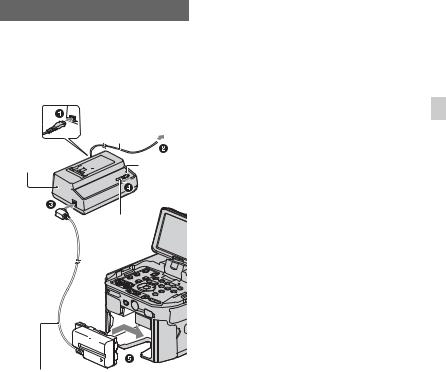
Using an outside power source
By using the AC Adaptor/Charger and the connecting cord DK-415 (supplied), you can use the camcorder on AC power, without worrying about running out of power.
To the wall outlet (wall socket)
Power cord
AC Adaptor/
Charger 
 Charge
Charge
lamp
Mode switch
Connecting cord
DK-415
1Connect the power cord (mains lead) to the AC Adaptor/Charger.
2Connect the power cord (mains lead) to the wall outlet (wall socket).
3Connect the connecting cord (DK-415) to the AC Adaptor/Charger.
4Set the mode switch of the AC Adaptor/ Charger to VCR/CAMERA.
5Press the connecting part of the connecting cord (DK-415) against the back of your camcorder in the battery slot and slide it in the direction of the arrow.
On the AC Adaptor/Charger
•Use the nearby wall outlet when using the AC Adaptor/Charger. Disconnect the AC Adaptor/ Charger from the wall outlet (wall socket) immediately if any malfunction occurs while using your camcorder.
•Do not use the AC Adaptor/Charger placed in a narrow space, such as between a wall and furniture.
•Do not short-circuit the DC plug of the AC Adaptor/Charger or battery terminal with any metallic objects. This may cause a malfunction.
•Even if your camcorder is turned off, AC power (house current) is still supplied to it while connected to the wall outlet (wall socket) via the AC Adaptor/Charger.
Started Getting
17
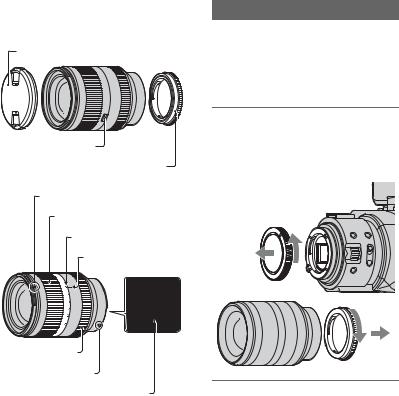
Step 4: Attaching the lens
This manual explains how to attach a lens using the E18-200 mm F3.5-6.3 OSS lens that comes with NEX-FS100EK/FS100PK.
Front lens cap
Zoom lock switch
Rear lens cap
Hood index
Zooming ring
Focal-length scale
Focal-length index
Focusing ring
Mounting index
Lens contacts*
* Do not touch or dirty the lens contacts.
Attaching the lens
Hold the camcorder body with the front end downward, and quickly change the lens somewhere away from dusty locations so as to keep dust or debris from getting inside the camcorder body.
1 Remove the body cap from the camcorder body and the packaging lid from the rear of the lens.
2 Mount the lens by aligning the mounting indexes (white) on the lens and the camcorder body. While pushing the lens lightly toward the camcorder body, turn the lens clockwise until it clicks into the locked position.
Be sure to put the lens on straight.
18

Mounting indexes (white)
b Notes
•When attaching a lens, do not press the lens release button.
•Do not use force when attaching a lens. Mounting the lens forcibly may result in a malfunction or damage of the lens mount.
•There may be a gap between the lens and the lens mount, depending on the lens attached. This is normal.
z Tips
•When you have changed the lens, it is recommended to adjust the black balance (p. 34) before recording. When you adjust the black balance, make sure that the front lens cap is attached.
Removing the lens
1 While pressing the lens release button all the way in, turn the lens counterclockwise until it stops.
•When you remove the lens, make sure that you hold both of the lens and the camcorder body.
Lens release button
2 Replace the packaging lid on the |
Getting |
|
Started |
||
the camcorder body. |
||
lens and attach the body cap to |
|
•Align the mark on the body cap to the mounting indexes, and turn the cap clockwise.
Align the marks.
•Before you attach caps, remove dust from them.
b Notes
•When changing the lens, if dust or debris gets inside the camcorder body and adheres to the surface of the image sensor (the part that acts as the film), it may appear on the image, depending on the shooting conditions. The image sensor is applied with the anti-dust coating, to prevent dust from adhering to the image sensor. However, attach or remove the lens quickly somewhere away from dusty locations.
•Do not leave the camcorder body with the lens and body cap removed.
Continued , 19
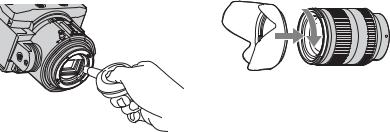
Step 4: Attaching the lens (Continued)
If dust or debris adheres on the image sensor
Turn off the camcorder and detach the lens. Clean the image sensor and the surrounding area using a blower (sold separately), and then reattach the lens.
b Notes
•Do not use a spray blower because it may scatter water droplets inside the camcorder body.
•Do not put the tip of a blower into the cavity beyond the mount, so that the tip of the blower does not touch the image sensor.
•Hold the camcorder’s face downward to prevent the dust from resettling in the camcorder.
•Do not apply a mechanical shock to the camcorder during cleaning.
•If you cannot clean the image sensor by the above procedure, consult your Sony dealer or local authorized Sony service facility.
A-mount lenses
•You need a Mount Adaptor (sold separately) to use A-mount lenses. For details, refer to the operating manuals that come with the Mount Adaptor.
•When an A-mount lens is attached, you cannot use the auto focus and auto iris functions. You may not be able to use certain A-mount lenses. For the compatibility of a particular A-mount lens, visit the Sony website in your area, or consult your Sony dealer or local authorized Sony service facility.
To attach the lens hood
Align the red line of the lens hood to that of the lens and mount the lens hood on the lens. Turn the lens hood clockwise until the red dot of the lens hood and the red line of the lens align with a click.
When storing the lens, fit the lens hood onto the lens backwards.
20

Step 5: Turning on the camcorder and setting the date and time
Turning on the camcorder
Slide the POWER switch to ON while you press the green button.
When you use your camcorder for the first time, the [CLOCK SET] screen appears.
Press and hold the green button.
Started Getting
SEL/PUSH EXEC |
MENU button |
dial |
|
Skip to step 4 when you set the clock for the first time.
1 Press the MENU button.
To turn off the power
Slide the POWER switch to OFF.
b Notes
•If warning messages appear on the screen, follow the instructions.
2 Select  (OTHERS) by turning the SEL/PUSH EXEC dial, then press the dial.
(OTHERS) by turning the SEL/PUSH EXEC dial, then press the dial.
Setting the date and time
Set the date and time when you use your camcorder for the first time.
z Tips
•If you do not use your camcorder for about 3 months, the built-in rechargeable battery gets discharged and the date and time settings may be cleared from the memory. In that case, charge the rechargeable battery and then set the date and time again (p. 108).
3 Select [CLOCK SET] by turning the SEL/PUSH EXEC dial, then press the dial.
Continued , 21
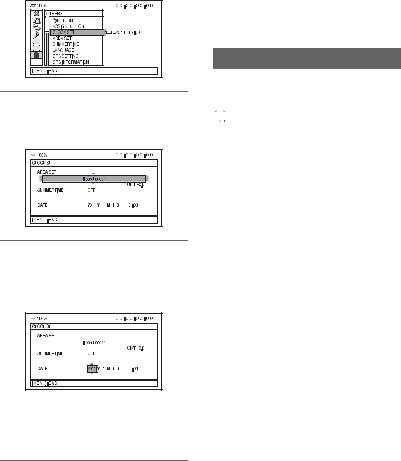
Step 5: Turning on the camcorder and setting the date and time (Continued)
the correct time automatically, depending on the country/region selected for your camcorder. In this case, set [AUTO CLOCK ADJ] and [AUTO AREA ADJ] to [OFF].
4 Select your area by turning the SEL/PUSH EXEC dial, then press the dial.
5 Set [SUMMERTIME], [Y] (year), [M] (month), [D] (day), hour and minute, by turning the SEL/PUSH EXEC dial, then press the dial.
The clock starts.
•Set [SUMMERTIME] to [ON] to move the time forward 1 hour.
•You can set any year up to the year 2037.
z Tips
•The date and time are automatically recorded on the selected recording media, and can be displayed during playback (DATA CODE button, p. 54).
•Once the clock is set, the clock time is automatically adjusted with [AUTO CLOCK ADJ] (p. 81) and [AUTO AREA ADJ] (p. 81) set to [ON]. The clock may not be adjusted to
Changing the language setting
You can change the on-screen displays to show messages in a specified language. Press the MENU button and select
 (OTHERS) with the SEL/PUSH EXEC dial. Select the screen language in [LANGUAGE] (p. 80).
(OTHERS) with the SEL/PUSH EXEC dial. Select the screen language in [LANGUAGE] (p. 80).
22

Step 6: Inserting a memory card/Attaching a flash memory unit
Memory card
Types of memory cards you can use in your camcorder
|
SD Speed Class |
Described in this manual |
|
“Memory Stick PRO |
|
|
|
Duo” media (Mark2) |
- |
“Memory Stick PRO |
|
“Memory Stick PRO- |
Duo” media |
||
|
|||
HG Duo” media |
|
|
|
|
|
|
|
SD memory card |
|
|
|
|
|
|
|
SDHC memory card |
|
|
|
|
Class 4 or faster |
SD card |
|
SDXC memory card* |
Types of memory cards you can use with Slow & Quick Motion recording
SD Speed Class |
Described in this manual |
|
|
“Memory Stick PRO-
HG Duo” media 

 “Memory Stick PRO
“Memory Stick PRO
-
Duo” media
SD memory card
SDHC memory card
SDXC memory card* |
Class 10 or faster |
SD card |
Started Getting
*Movies recorded on SDXC memory cards cannot be imported to or played back on computers or A/V devices not supporting the exFAT file system, that is used for SDXC memory cards, by connecting the camcorder to these devices with the USB cable. Confirm in advance that the connecting equipment is supporting the exFAT system. If you connect equipment not supporting the exFAT system and the format screen appears, do not perform the format. All the data recorded will be lost.
b Notes
•Operation with all memory cards is not assured.
•“Memory Stick PRO Duo” media, half the size of “Memory Stick” media, or standard size SD cards can be used for this camcorder.
•Do not attach a label or the like on memory card or memory card adaptor. Doing so may cause a malfunction.
•“Memory Stick PRO Duo” media of up to 32 GB and SD cards of up to 64 GB have been verified to operate with your camcorder.
•See page 99 for the recordable time of memory cards.
•A MultiMedia Card cannot be used with this camcorder.
Continued , 23
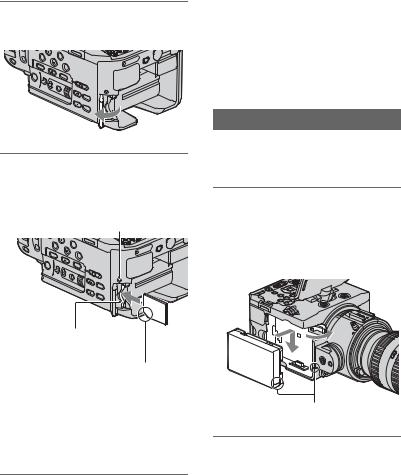
Step 6: Inserting a memory card/Attaching a flash memory unit (Continued)
1 Open the cover in the direction of the arrow.
2 Insert the memory card with the notched edge in the direction as illustrated until it clicks.
Access lamp
Memory card slot
Note the direction of notched corner.
b Notes
•If you insert a memory card into the slot in the wrong direction, the memory card, the memory card slot, or image data may be damaged.
To eject the memory card
Lightly push the memory card once.
b Notes
•When the access lamp is lit or flashing in red, your camcorder is reading/writing data. Do not shake or knock your camcorder, turn the power
off, eject the memory card, or remove the battery pack. Otherwise, image data may be damaged.
•If [The image database file is corrupted. The media must be restored to use again.] appears in step 2, format the memory card (p. 63).
•When inserting or ejecting the memory card, be careful to prevent the memory card from popping out and dropping.
Flash memory unit
You can attach a flash memory unit HXRFMU128 (sold separately) to your camcorder for recording movies.
While sliding the RELEASE lever, align the mark on the camcorder with the one on the flash memory unit, and slide the flash memory unit in the direction of the arrow.
Align the marks.
To remove the flash memory unit
Turn off your camcorder, and while sliding the RELEASE lever in the direction of arrow, remove the flash memory unit.
24
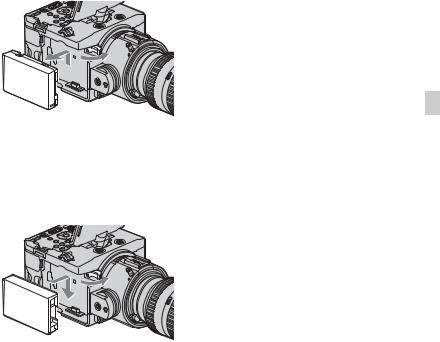
When you do not use a flash memory unit
Leave the flash memory unit jack cover attached.
While sliding the RELEASE lever in the direction of the arrow, attach the flash memory unit jack cover.
z Tips
•Your camcorder does not have the relay recording function. If the memory card is fully recorded during recording, the camcorder stops recording automatically.
•You can record movies on both of the memory card and the flash memory unit simultaneously (p. 27).
Started Getting
25
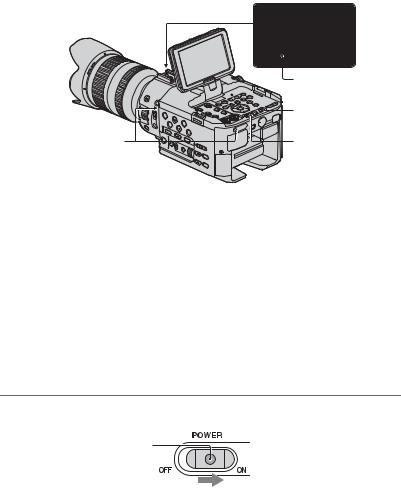
Recording/Playback
Recording
|
START/STOP button |
|
START/STOP button |
Recording lamps |
POWER switch |
Your camcorder records movies on a memory card and/or a flash memory unit. Do the following steps to record movies.
•This camcorder can record movies in either high definition image quality (HD) or standard definition image quality (SD). The factory setting is high definition image quality (HD) ([ /
/ SET], p. 28).
SET], p. 28).
b Notes
•When the access lamp is lit or flashing in red, your camcorder is writing data on recording media. Do not shake or knock your camcorder, or remove the battery pack or the AC Adaptor/Charger.
•See page 99 on the recording time of movies.
•Your camcorder can record a movie for about 13 hours continuously.
•If a movie file exceeds 2 GB during recording, the camcorder divides the file and create a new file automatically.
•The menu settings, the PICTURE PROFILE settings, and the settings made by the AUTO/MANUAL switch are stored in your camcorder when you slide the POWER switch to OFF. The access lamp lights up while the settings are being stored. If you remove the battery pack or the AC Adaptor/Charger before turning off the power, the settings may return to the default settings.
1 Slide the POWER switch to ON while pressing the green button.
Press and hold the green button.
26

2 Press the START/STOP button.
[STBY] t [REC]
The recording lamp lights up during recording.
To stop the movie recording, press the START/STOP button again.
z Tips
•When recording in high definition image quality (HD), the aspect ratio is fixed to 16:9. When recording in standard definition image quality (SD), you can switch the aspect ratio to 4:3 ([ WIDE REC], p. 73).
WIDE REC], p. 73).
•You can change the screen display during recording (p. 54).
•Indicators displayed on the screen during recording are shown on page 120.
•The recording lamp can be set to stay off ([REC LAMP[F]], [REC LAMP[R]], p. 82).
•You can capture still images from the movies you recorded (p. 59).
To record movies using both the memory card and the flash memory unit (Simultaneous recording)
You can record movies on both of these recording media simultaneously.
Press MENU t select  (REC/OUT SET) t [REC SET] t [
(REC/OUT SET) t [REC SET] t [ SIMULTANEOUS REC] t [ON] (default setting) with the SEL/PUSH EXEC dial.
SIMULTANEOUS REC] t [ON] (default setting) with the SEL/PUSH EXEC dial.
z Tips
• Set [ /
/ SET] to [
SET] to [ ] (p. 28) for the simultaneous recording.
] (p. 28) for the simultaneous recording.
• If one of the recording media used becomes unable to continue recording during simultaneous recording, the other recording media continues recording without pause.
• When [ |
SIMULTANEOUS REC] is [ON], movies are recorded on both media, irrespective of the |
|
[ |
REC MEDIA SETTING] setting. |
|
To record movies only on the memory card or the flash memory unit
1Press MENU t select (REC/OUT SET) t [REC SET] t [
(REC/OUT SET) t [REC SET] t [ SIMULTANEOUS REC] t [OFF].
SIMULTANEOUS REC] t [OFF].
2Select  (REC/OUT SET) t [REC SET] t [
(REC/OUT SET) t [REC SET] t [ REC MEDIA SETTING] t [MEMORY CARD] or [FMU] (flash memory unit).
REC MEDIA SETTING] t [MEMORY CARD] or [FMU] (flash memory unit).
zTips
•A message appears if an access error occurred while the camcorder was accessing the recording media. During simultaneous recording, the [STBY]indicator and the icon of the recordable medium appears on the screen.
Recording/Playback
Continued , 27
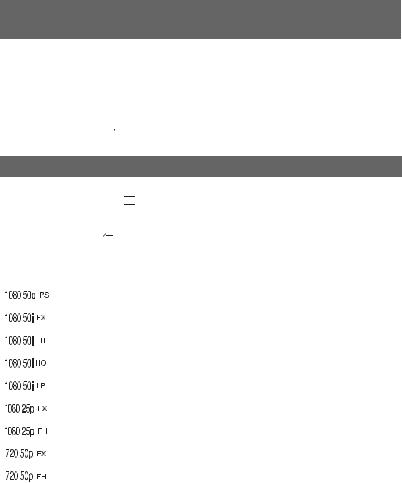
Recording (Continued)
Selecting high definition image quality (HD) or standard definition image quality (SD)
You can select the desired image quality from the high definition image quality (HD) that enables you to record fine images, or the standard definition image quality (SD) that has more compatibility with various playback devices ([HD] is the default setting). Change the image quality according to the recording situation or the playback device.
To change the setting
Press MENU t select  (REC/OUT SET) t [REC SET] t [
(REC/OUT SET) t [REC SET] t [ /
/ SET] t [
SET] t [ ] or [
] or [ ] with the SEL/PUSH EXEC dial.
] with the SEL/PUSH EXEC dial.
Selecting the recording format
You can select the recording format (bit-rate, image size, frame rate, scanning system). In the default setting, [




 ] is selected.
] is selected.
To change the setting
Press MENU t select  (REC/OUT SET) t [REC SET] t [
(REC/OUT SET) t [REC SET] t [ REC FORMAT] t a desired format with the SEL/PUSH EXEC dial.
REC FORMAT] t a desired format with the SEL/PUSH EXEC dial.
Setting value |
Description |
||||||
|
|
|
|
|
|
|
• Bit-rate |
|
|
|
|
|
|
|
|
|
|
|
|
|
|
|
PS: max. 28 Mbps |
|
|
|
|
|
|
|
FX: max. 24 Mbps |
|
|
|
|
|
|
|
|
|
|
|
|
|
|
|
FH: approx. 17 Mbps (average) |
|
|
|
|
|
|
|
HQ: approx. 9 Mbps (average) |
|
|
|
|
|
|
|
|
|
|
|
|
|
|
|
LP: approx. 5 Mbps (average) |
|
|
|
|
|
|
|
|
|
|
|
|
|
|
|
• Image size |
|
|
|
|
|
|
|
|
|
|
|
|
|
|
|
|
|
|
|
|
|
|
|
PS: 1920×1080 |
|
|
|
|
|
|
|
|
|
|
|
|
|
|
|
FX: 1920×1080/1280×720 |
|
|
|
|
|
|
|
|
|
|
|
|
|
|
|
|
|
|
|
|
|
|
|
FH: 1920×1080/1280×720 |
|
|
|
|
|
|
|
|
|
|
|
|
|
|
|
HQ: 1440×1080 |
|
|
|
|
|
|
|
|
|
|
|
|
|
|
|
|
|
|
|
|
|
|
|
LP: 1440×1080 |
|
|
|
|
|
|
|
|
|
|
|
|
|
|
|
• Frame rate |
|
|
|
|
|
|
|
|
|
|
|
|
|
|
|
|
|
|
|
|
|
|
|
either 25 or 50 |
|
|
|
|
|
|
|
|
|
|
|
|
|
|
|
• Scanning system |
|
|
|
|
|
|
|
|
|
|
|
|
|
|
|
|
|
|
|
|
|
|
|
i: interlace |
|
|
|
|
|
|
|
|
|
|
|
|
|
|
|
p: progressive |
|
|
|
|
|
|
|
|
|
|
|
|
|
|
|
|
|
|
|
|
|
|
|
|
28
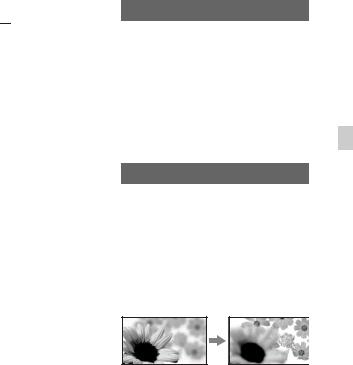
Setting value
If you select [



 ], for example, movies are recorded with following format.
], for example, movies are recorded with following format.
•1080: Effective scanning lines
•25: Frame rate
•p: Scanning system
•FX: Recording mode
b Notes
•The recording mode is fixed to FX or FH with the progressive scanning system.
•You can save movies that have been recorded
with [1080/50p PS] or [1080/50i FX] of [ REC FORMAT] on an external media device only (p. 83).
REC FORMAT] on an external media device only (p. 83).
z Tips
•The recording format of [576/50i HQ] is automatically selected for the standard image quality (SD) recording.
Zooming
Turn the zooming ring right or left to decide on the size of the subject in your image. Zooming must be done before focusing.
b Notes
•The operations and operating methods available depend on the lens attached. Refer to the operating manuals that comes with your lens.
•Do not grab or apply a strong force to the lens cylinder that rolls out when zooming. The lens may be damaged.
Adjusting the focus
You can adjust the focus manually for different recording conditions.
Use this function in the following cases.
–To record a subject behind a window covered with raindrops.
–To record horizontal stripes.
–To record a subject with little contrast between the subject and its background.
–When you want to focus on a subject in the background.
– To record a stationary subject using a tripod.
Recording/Playback
Continued , 29
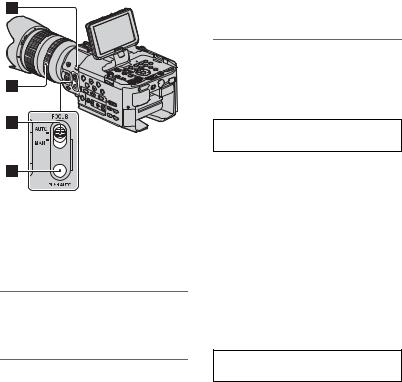
Recording (Continued)
b Notes
•When you use A-mount lenses (sold separately), you cannot use following functions and buttons.
–Auto focus
–Button D
–FOCUS switch Cat the AUTO position
1 During recording or standby, set the FOCUS switch C to MAN.
9 appears.
2 Rotate the focusing ring Band adjust the focus.
9 changes to  when the focus cannot be adjusted any farther. 9 changes to
when the focus cannot be adjusted any farther. 9 changes to  when the focus cannot be adjusted any closer.
when the focus cannot be adjusted any closer.
z Tips
For focusing manually
•It is easier to focus on the subject when you use the zoom function. Zoom towards T (telephoto) to adjust the focus, and then, towards W (wide angle) to adjust the zoom for recording.
•When you want to record a close-up image of a subject, fully zoom out towards W (wide angle), then adjust the focus.
To restore automatic adjustment
Set the FOCUS switch C to AUTO. 9 disappears and the automatic focus adjustment is restored.
Using automatic focus temporarily (Push auto focus)
Record the subject while pressing and holding the PUSH AUTO button D.
If you release the button, the setting returns to manual focusing.
Use this function to shift the focus on one subject to another. The scenes will shift smoothly.
z Tips
•The focal distance information (for when it is dark and hard to adjust the focus) appears for about 3 seconds in the following cases.
–When you set the FOCUS switch Cto MAN and 9 appears on the screen.
–When you rotate the focusing ring while 9 is displayed on the screen.
Using the expanded focus (Expanded focus)
Press the EXPANDED FOCUS button A. [EXPANDED FOCUS] appears and the center of the screen is magnified by about 2.0 times. It will be easier to confirm the focus setting during manual focusing. The screen returns to the original size when you press the button again.
b Notes
•Even though the image appears expanded on the screen, the recorded image is not expanded.
•You cannot use the expanded focus with the SMOOTH SLOW REC function (p. 45).
30
